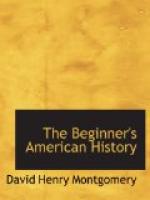[Illustration: Monument to Columbus. (In the Cathedral of Havana, Cuba.)]
[Footnote 18: Havana (Ha-van’ah): a city of Cuba.]
20. Summary.—In 1492 Christopher Columbus set sail from Spain to find a direct way across the Atlantic to Asia and the Indies. He did not get to Asia; but he did better; he discovered America. He died thinking that the new lands he had found were part of Asia; but by his daring voyage he first showed the people of Europe how to get to the New World.
When and where was Columbus born? What did he do when he was fourteen? What about his sea-fight? What did he do in Lisbon? How much of the world was then known? How did Columbus think he could reach Asia and the Indies? Why did he want to go there? What did he try to do in Portugal? Why did he go to Spain? Where did he first go in Spain? How did Columbus get help at last? When did he sail? What happened on the first part of the voyage? What happened after that? What is said about signs of land? What about the discovery of land? What did Columbus name the island? What did he find on it? What is said of other islands? What is said of the return of Columbus to Spain? What about the last voyages of Columbus? Did he ever land on any part of what is now the United States? What about his old age? What is said of his death and burial?
John Cabot[1]
(Lived in England from 1472-1498).
21. John Cabot discovers the continent of North America.—At the time that Columbus set out on his first voyage across the Atlantic in 1492, John Cabot, an Italian merchant, was living in the city of Bristol,[2] England. When the news reached that city that Columbus had discovered the West Indies, Cabot begged Henry the Seventh, king of England, to let him see if he could not find a shorter way to the Indies than that of Columbus. The king gave his consent, and in the spring of 1497 John Cabot, with his son Sebastian,[3] who seems to have been born in Bristol, sailed from that port. They headed their vessels toward the northwest; by going in that direction they hoped to get to those parts of Asia and the Spice Islands which were known to Europe, and which Columbus had failed to reach.
[Illustration: Map showing the city of Venice, Italy, where John Cabot had lived.]
Early one bright morning toward the last of June, 1497, they saw land in the west. It was probably Cape Breton[4] Island, a part of Nova Scotia.[5] John Cabot named it “The Land First Seen.” Up to this time Columbus had discovered nothing but the West India Islands, but John Cabot now saw the continent of North America; no civilized man[6] had ever seen it before. There it lay, a great, lonely land, shaggy with forests, with not a house or a human being in sight.
[Illustration: Map showing Nova Scotia.]
[Footnote 1: Cabot (Cab’ot).]
[Footnote 2: See map in paragraph 62.]




